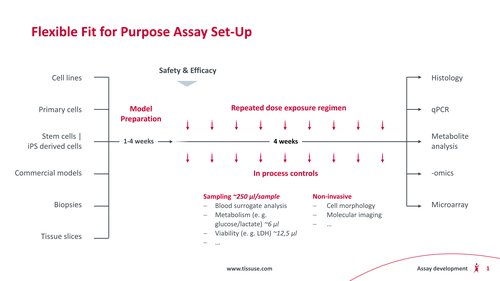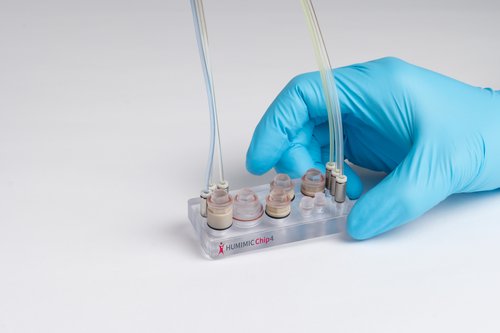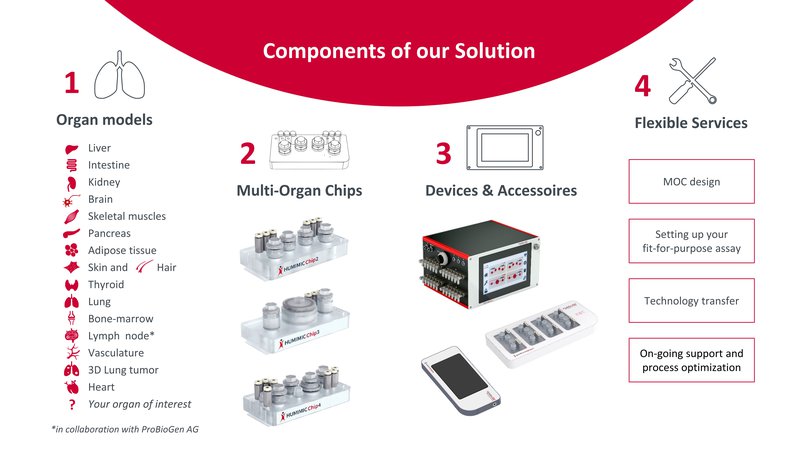TissUse GmbH "Multi-Organ-Chip” platform

Solving risk assessment issues
TissUse is a Berlin, Germany-based, biotechnology company, which has developed a unique “Multi-Organ-Chip” platform that provides unparalleled preclinical insight on a systemic level using human tissues. This enabling technology platform consists of a miniaturized construct that closely simulates the activity of multiple human organs in their true physiological context. TissUse’s Multi-Organ-Chips provide a new approach to predict, for example, toxicity, ADME profiles and efficacy in vitro, reducing and replacing laboratory animal testing and streamlining human clinical trials. TissUse’s Multi-Organ-Chips have been utilized in a large variety of applications including drug development, cosmetics, food and nutrition and consumer products since 2012.

TissUse has developed a unique, proprietary and patent-protected “multi-on-a-chip” technology platform to accelerate the development of pharmaceutical, chemical, cosmetic, and personalized medical products.
This technology – for the first time ever – provides preclinical insight on a systemic level using human tissue and enables the direct prediction of effects of chemicals and their metabolism on near real-life models.
The platform is a miniaturized construct that closely simulates the activity of multiple human organs in their true physiological context at the smallest possible biological scale.
- Microfluidic chip format of a standard microscopic slide
- Tissue cultures 100,000-fold smaller than original organs
- Dynamic circulation with perfusion
- On-chip micro-pump and natural tissue to fluid ratio
- Variable physiological shear stresses applicable
- Compatible with live tissue imaging
- Designed to work with existing lab equipment
- Rapid prototyping of any relevant chip design
The organ models are connected by microfluidic channels in a closed circuit. An on-chip pump enables a near life-like nutrient and oxygen supply to the cells. This allows for detailed studies of distribution and metabolization of various substances like drugs, cosmetics, chemicals, and food additives enabling the prediction of substance effects. The HUMIMIC Chips are designed for use with non-invasive in-process controls like fluorescence microscopy
and other optical methods.

The HUMIMIC Chip2 allows the simultaneous culture of two different organ models, while HUMIMIC Chip3 and Chip3 Plus allows the simultaneous culture of three different organ models. Cells and tissues can be used to emulate biological barriers like the intestine, lung or skin, as well as to grow spheroidal and matrix-supported cultures for mimicking the three-dimensional environment of organs like the liver.

The HUMIMIC Chip4 enables easy integration of up to four different organ models, e. g. a combination of intestine, liver, kidney and neuronal tissue in one system. The PBPK-compliant design allows for quantitative in vitro to in vivo extrapolation. The HUMIMIC Chip4 uses two separate microfluidic circuits including a blood and a urine circuit interconnected with a porous membrane to model processes like excretion and reabsorption of various substances in the kidney model.
Multi-Organ-Chips require a Control Unit. The HUMIMIC Starter delivers 24 pre-calibrated pneumatic connectors for optimal operation of the on-chip pumps. Pumping pressure can be adjusted and is then applied automatically by the HUMIMIC Starter. This product is equipped with a USB-port for easy management of pressure profiles and transfer of data. The HUMIMIC Starter is compatible with HUMIMIC Chip2, Chip3, Chip3plus and Chip4.
TissUse business model includes product sales, contract research and services including technology transfer.
